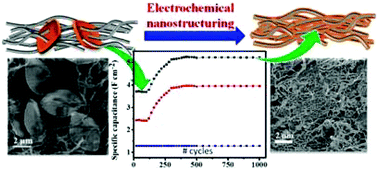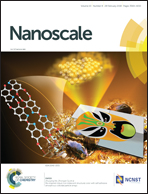Electrochemical, top-down nanostructured pseudocapacitive electrodes for enhanced specific capacitance and cycling efficiency†
Abstract
Stabilization of the electroactive redox centers on ideally polarisable conductive electrodes is a critical challenge for realizing stable, high performing pseudocapacitive energy storage devices. Here, we report a top-down, electrochemical nanostructuring route based on voltammetric cycling to stabilize β-MnO2 on a single walled carbon nanotube (CNT) scaffold from a MnMoO4 precursor. Such in situ nanostructuring results in controlled disintegration of an ∼8 μm almond like structure to form ∼29 nm β-MnO2 resulting in a 59% increase in the specific surface area and a 31% increase in the porosity of the pseudocapacitive electrode. Consequently, the specific capacitance and areal capacitance increase by ∼75% and ∼40%, respectively. Such controlled, top-down nanostructuring is confirmed through binding energy changes to Mo 3d, C 1s, O 1s and Mn 2p respectively in XPS. Furthermore, Raman spectral mapping confirms the sequential nanostructuring initiating from the interface of CNTs with MnMoO4 and proceeding outwards. Thus, the process yields the final CNT/β-MnO2 electrode that is electrically conductive, facilitates rapid charge transfer, and has increased capacitance and longer stability. Furthermore, the charge-transfer resistance and equivalent resistance are significantly lower compared to conventional activated carbon based electrodes.



 Please wait while we load your content...
Please wait while we load your content...